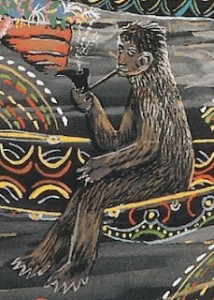Mestizos in the Upper Amazon have a variety of beliefs about the other-than-human persons who inhabit the hidden realms deep in the jungle and under the water. These beings are often conceived as inhabiting the three realms of air, earth, and water; all of them are dangerous. They are different from the madres or genios, the spirits of plants and animals with whom the shaman interacts, although shamans often seek to enter into right relationship with these beings as well; rather, ordinary people may, to their sorrow, unintentionally and unexpectedly encounter these more-or-less corporeal other-than-human persons.
The yacuruna, the water people, look more or less like human beings, except that they live underwater in beautiful cities, often at the mouths of rivers. Sometimes these cities are described as upside-down mirror images of human cities — that is, like reflections on the surface of the water. Here the yacuruna live in palaces of crystal with multicolored walls of fish scales and pearl, reclining on hammocks of gazelle feathers, under a mosquito net of butterfly wings. These tropes can be extended: the hammocks of the yacuruna are boas, their seats are turtles, their canoes are alligators. In different accounts, yacuruna may be hairy, or have their heads turned backwards, or even have deformed feet, like the chullachaqui.
People stolen away by the yacuruna come in time to resemble their captors: first their eyes and then their head and feet turn backwards. When the transformation is complete, the stolen one has turned into a yacuruna, and can never return. Or the yacuruna may turn around the head of the one they have abducted immediately, so that the person cannot find the way home, but must continue onward into their city under the water.
 |
| A hairy yacuruna sits on a boa hammock smoking a pipe (detail from a painting by Pablo Amaringo) |
The yacuruna are also great healers, and can be summoned to help the shaman in his work. The yacuruna may teach an abducted person the healing arts and, when trust has been established, turn the person’s head toward the front again, and let the person return to the human world. Similarly, the yacuruna may be the source of shamanic powers.
Belief in powerful underwater beings is found elsewhere in the Amazon. Among the Achuar, the tsunki are male and female spirits who resemble humans and dwell in rivers and lakes, very much like the yacuruna among the mestizos. Tsunki social and material life mirrors that of the Achuar; they are a source of shamanic powers; and they engage in sexual relations with humans. Married Achuar men speak casually about their double life with their human family on the one hand and their adulterous underwater tsunki family on the other.
Among the Shuar, the shamanic power of the water people is made explicit, and they attribute great shamanic power to the tsunki. Indeed, Tsunki is the primordial first shaman, the source of all shamanic power, the origin of knowledge about the use of tsentsak darts, who continues to live beneath the waters in a house made of anacondas, using a turtle as a stool. Tsunki can give to favored shamans a type of tsentsak made of crystal, which are particularly deadly; and he can kill shamans with whom he is angry. It is possible to receive tsentsak directly from Tsunki in a dream or vision, instead of receiving them from a human shaman. It is sometimes said that only those who have had a vision of Tsunki can become a shaman. A Shuar shaman sings, I am like Tsunki. I am like Tsunki. And again: I am sitting with Tsunki.
Tsunki lives in the whirlpools of the remote waterfalls, and appears in the form of a beautiful woman, a water snake, or other water being. Thus there is ambiguity: the term tsunki can refer to the water people generally; to a particular water person, often a seductive female with long hair and large breasts, at least as reported by men; and to Tsunki, the primordial shaman. All of them offer gifts of power.

- Previous Post: The Idea of the Wilderness
- Next Post: Chullachaqui
- More Articles Related to: Indigenous Culture, The Amazon


